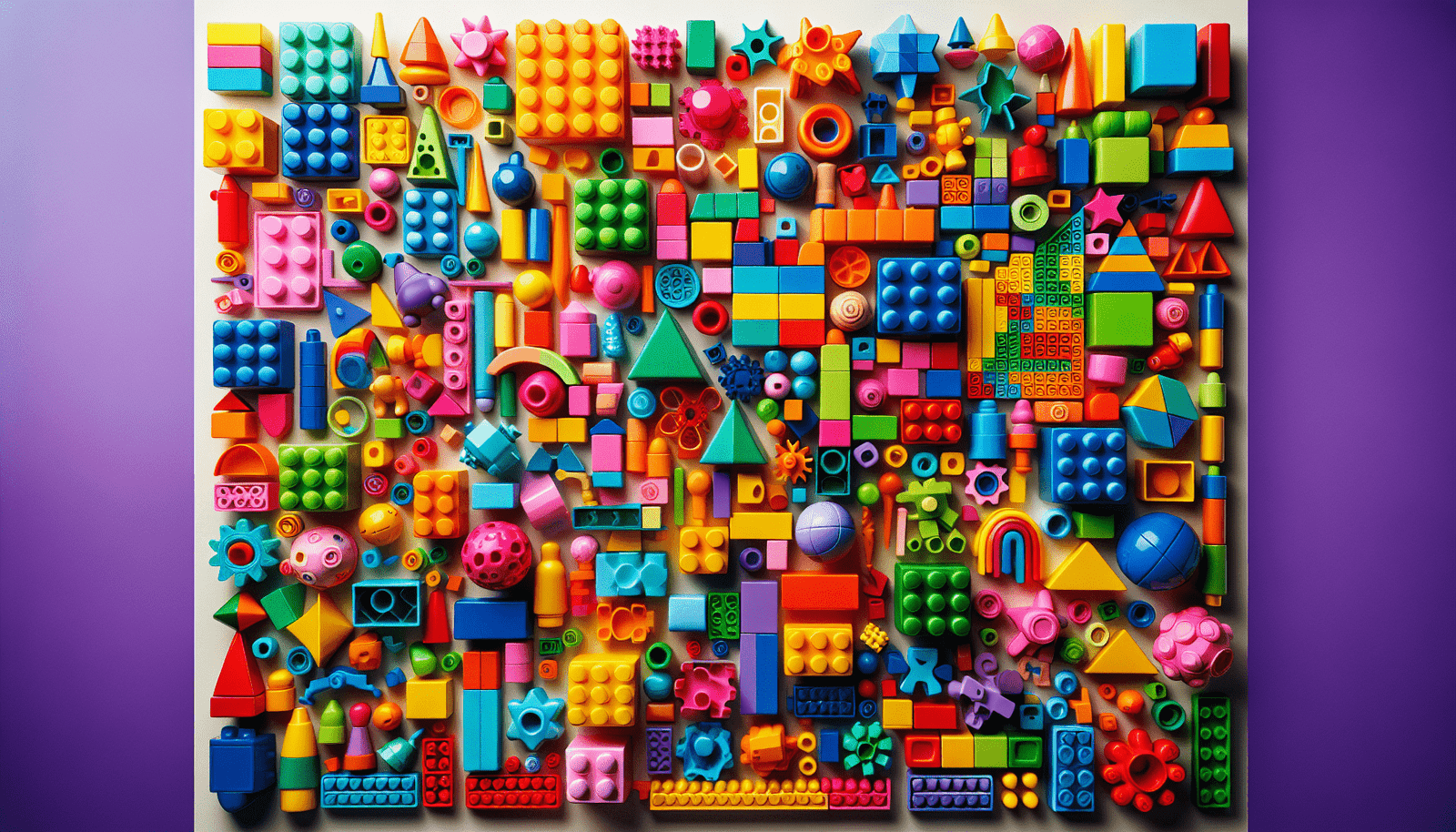Are you a parent or an educator searching for the best ways to engage and educate children? Look no further than building toys. In this article, we will explore why building toys are superior to screen time when it comes to your child’s development. From fostering creativity and problem-solving skills to promoting physical and cognitive development, building toys offer countless benefits that screens simply cannot match. So, if you’re looking for a fun and educational alternative to keep your child engaged, join us as we delve into the world of building toys and discover why they are the superior choice.
Building Toys Vs Screen Time
Understanding Screen Time’s Impacts
In today’s digital age, screen time has become a common aspect of children’s lives. However, it is important to understand the impacts excessive screen time can have on their development. Studies have shown that too much screen time can negatively affect children in various ways.
Negative Effects of Excessive Screen Time on Children
Excessive screen time has been linked to a range of negative effects on children. One of the most concerning impacts is the potential harm to their physical health. Extended periods of sedentary behavior in front of screens can contribute to a sedentary lifestyle, leading to issues such as obesity and poor cardiovascular health.
Screen time can also interfere with sleep patterns, as the blue light emitted by screens can disrupt the production of melatonin, a hormone responsible for regulating sleep. This can result in difficulties falling asleep and decreased overall sleep quality, which can have a detrimental effect on children’s overall health and well-being.
Additionally, excessive screen time has been associated with delays in language development and decreased attention spans in children. It can hinder their ability to engage in face-to-face social interactions and develop important social and emotional skills.
Benefits of Limited Screen Time
While too much screen time can have negative effects, it’s important to acknowledge that limited screen time can also have some benefits for children. Age-appropriate educational content and interactive learning apps can provide valuable opportunities for cognitive development and skill-building.
Screen time can also offer a means of connecting with others, especially for children who may have limited social interactions outside of their immediate family. Platforms such as video calls or social media can help children maintain relationships with friends and family members who are geographically distant.
How Screen Time Interferes with Child Development
Screen time has the potential to interfere with various aspects of a child’s development. One area it can impact is language development. Excessive screen time may reduce the amount of time children spend engaging in meaningful conversations and interacting with others, which is crucial for language acquisition.
Furthermore, prolonged exposure to screens can negatively affect children’s attention spans and concentration abilities. The constant stimulation and instant gratification provided by screens can make it difficult for children to focus on tasks that require sustained attention, such as reading or problem-solving.
Screen time can also hinder the development of fine motor skills. Activities such as building with blocks or manipulating objects are important for developing dexterity and coordination. When children spend excessive time on screens, they miss out on these opportunities for hands-on learning and skill development.
Building Toys and their Benefits
Building toys are a fantastic alternative to excessive screen time, offering numerous benefits for children’s development. Let’s explore the advantages of incorporating building toys into your child’s playtime.
Defining Building Toys
Building toys encompass a wide variety of objects such as blocks, LEGO sets, magnetic tiles, and more. These toys allow children to use their creativity and imagination to construct different structures, designs, and worlds. They promote hands-on learning and problem-solving, making them an excellent choice for educational play.
Role of Building Toys in Educational Play
Building toys play a crucial role in educational play. They offer children an opportunity to engage in open-ended play, where there are no predetermined outcomes. This freedom encourages creativity, critical thinking, and problem-solving skills as children navigate challenges and find solutions on their own.
By engaging with building toys, children develop spatial awareness, mathematical concepts, and logical reasoning skills. They learn about balance, symmetry, and cause-and-effect relationships, laying a solid foundation for STEM subjects (science, technology, engineering, and mathematics).
Physical Benefits of Playing with Building Toys
Playing with building toys offers significant physical benefits for children. As children manipulate blocks and other pieces, they develop fine motor skills, hand-eye coordination, and finger dexterity. These skills are crucial for everyday tasks, such as buttoning clothes, writing, and using utensils.
Building toys also promote gross motor skills as children engage in active play. For example, building large structures or participating in group activities that involve moving and arranging pieces can enhance their coordination and balance.
Cognitive Advancements with Building Toys
Building toys provide valuable cognitive advancements for children. As they construct various structures, children develop problem-solving skills and spatial reasoning. They learn to think critically, plan ahead, and adapt their designs as they encounter challenges along the way.
Furthermore, building toys foster creativity and imagination. Children have the freedom to create their own worlds and stories, allowing their imagination to soar. This creative play enhances their storytelling abilities, language development, and emotional expression.
Comparative Analysis: Building Toys vs. Screen Time
Understanding the different impacts of building toys and screen time is essential for making informed decisions about how children spend their time. Let’s compare the two and examine the effects they have on various aspects of a child’s development.
Sensory Development: Building Toys or Screen Time?
When it comes to sensory development, building toys have a clear advantage over screen time. Building with toys engages multiple senses – children can touch, feel, and manipulate objects, which aids in the development of their sensory skills.
On the other hand, screen time primarily engages the sense of sight and hearing. While some interactive apps may incorporate touch or sound, they cannot replicate the tactile experience provided by playing with building toys.
Screen Time vs. Building Toys: Which Enhances Cognitive Skills More?
Building toys have been found to enhance cognitive skills more effectively than screen time. The hands-on nature of building toys promotes problem-solving, critical thinking, and spatial reasoning, which are vital cognitive abilities.
On the contrary, excessive screen time has been associated with decreased attention spans and difficulties in sustained concentration. The passive nature of consuming content on screens does not provide the same level of cognitive stimulation and active engagement as building toys.
Analyzing the Influence on Social Skills
Building toys offer numerous opportunities for social interaction and collaboration. Children can work together to build structures, take turns, and share ideas. They learn important social skills, such as cooperation, communication, and negotiation, in a fun and interactive setting.
In contrast, screen time can hinder the development of social skills. Excessive use of screens can limit face-to-face interactions and reduce opportunities for children to practice important social and emotional skills. While some digital platforms allow for virtual interactions, they cannot fully replace the richness of real-life social interactions.
Studying the Impact on Creativity and Imagination
Building toys are renowned for their ability to foster creativity and imagination. They provide a blank canvas for children to create, design, and explore their own ideas. With building toys, children have the freedom to think outside the box, experiment with different possibilities, and bring their imagination to life.
Screen time, on the other hand, often restricts creativity and imagination. Digital content is pre-determined and limits children’s ability to create their own worlds. While some apps may encourage creativity through drawing or storytelling features, the overall experience is often more passive and constrained compared to building toys.
Striking a Balance Between Screen Time and Building Toys
Finding the right balance between screen time and building toys is crucial for a well-rounded and healthy childhood. By recognizing the need for a balanced approach and incorporating both into daily routines, parents and educators can ensure children reap the benefits of both worlds.
Recognizing the Need for a Balanced Approach
It is important to recognize that both screen time and building toys can offer valuable experiences and learning opportunities for children. However, excessive use of either can have negative effects on their development. Striking a balance is key to ensuring children benefit from the advantages of both activities.
Incorporating Screen Time and Building Toys into Daily Routines
To achieve a balanced approach, it is essential to incorporate both screen time and building toys into children’s daily routines. Set designated screen time periods that are age-appropriate and offer educational content. Supplement this with ample time for playing with building toys, whether independently or in a social setting.
By establishing a routine that includes both activities, children can enjoy the benefits of screen time while also engaging in hands-on, creative play with building toys.
Strategies to Encourage More Playtime with Building Toys
To encourage more playtime with building toys, parents and educators can employ various strategies. One effective method is to create a dedicated space for building toys, providing easy access and organization. This space can be filled with different types of building toys, allowing children to explore a wide range of possibilities.
Another strategy is to actively participate in playtime with building toys. By joining in and showing enthusiasm, adults can inspire children’s curiosity and creativity. Additionally, incorporating building toys into structured activities, such as challenges or building competitions, can make playtime more exciting and engaging.
Choosing the Right Building Toys for Each Age Group
When selecting building toys, it is important to consider the age and developmental stage of the child. Different building toys offer varying levels of complexity and challenges. Here are some recommendations for each age group:
Recommended Building Toys for Toddlers
For toddlers, building toys should focus on large, chunky pieces that are easy to manipulate. Duplo blocks, soft foam blocks, and stacking toys are excellent choices as they promote hand-eye coordination, fine motor skills, and sensory exploration.
Suggested Building Toys for Pre-schoolers
Pre-schoolers can handle more intricate building toys. LEGO Juniors sets, magnetic tiles, and interlocking blocks are ideal options for this age group. These toys encourage creativity, problem-solving, and the development of fine motor skills.
Best Building Toys for School-aged Children
School-aged children can engage with more complex building toys that challenge their cognitive abilities. LEGO Technic sets, architectural building kits, and robotics kits provide opportunities for advanced construction and engineering. These toys foster critical thinking, logical reasoning, and advanced motor skills.
Incorporating Building Toys Into Learn-Through-Play Scenarios
Building toys can be effective tools for incorporating hands-on learning into various settings, including classrooms and homes. Let’s explore the ways building toys can be incorporated into learn-through-play scenarios.
Building Toys in Classroom Settings
In the classroom, building toys can be used to support various areas of the curriculum. Teachers can incorporate building toys into science lessons to explore concepts such as structures and forces. They can also utilize them in math lessons to teach spatial awareness, measurement, and geometry.
Furthermore, building toys can facilitate collaboration and problem-solving in group projects. Students can work together to design and construct models, fostering teamwork and cooperative learning.
Creating Engaging Play Scenarios at Home
At home, building toys can be utilized to create engaging play scenarios that promote learning. Parents can encourage children to build replicas of famous landmarks, design their own inventions, or construct imaginative worlds. Through these play scenarios, children develop a deeper understanding of various subjects and enhance their creative thinking skills.
Parents can also incorporate building toys into storytelling activities, using the structures as props or constructing scenes to bring stories to life. This combination of imaginative play and language development enhances children’s storytelling abilities and sparks their imagination.
Educators’ Perspectives on Building Toys vs. Screen Time
Education experts recognize the benefits of building toys and often advocate for their inclusion in children’s playtime. Let’s explore some of the perspectives educators have on building toys compared to screen time.
Educational Experts’ take on Screen Time
Educational experts highlight the potential risks associated with excessive screen time. They emphasize the importance of moderation, selecting age-appropriate content, and ensuring that screen time is interactive and educational. Experts recommend that screens should not replace hands-on experiences and physical playtime, as these activities provide essential opportunities for children’s development.
Why Educators Support the Use of Building Toys
Educators wholeheartedly endorse the use of building toys in children’s playtime. They recognize the significant benefits building toys offer, such as hands-on learning, problem-solving, and cognitive development. Building toys allow children to explore their imagination, collaborate with peers, and develop important skills that are applicable across various subjects.
Educators also appreciate the versatility of building toys. They can be easily incorporated into classroom activities and used to teach a wide range of concepts. Building toys provide a tangible and engaging way for students to explore abstract concepts, enhancing understanding and retention.
Real-life Experiences from Teachers
Teachers often share real-life experiences that highlight the positive impact of building toys on children’s learning. They observe how building toys promote engagement, critical thinking, and creativity in the classroom. Students who struggle with traditional teaching methods often thrive when given the opportunity to learn through hands-on play with building toys.
Teachers also note the positive influence building toys have on collaborative skills. Working together to construct structures fosters teamwork, communication, and problem-solving. By witnessing students engaging in meaningful and cooperative play, teachers recognize the importance of building toys in promoting social and emotional growth.
Parents’ Views on Screen Time and Building Toys
Parents play a crucial role in shaping their children’s screen time and play experiences. Let’s gain insight into parents’ views and how they are incorporating building toys into their children’s playtime.
Understanding Parents’ Dilemma
Parents face the dilemma of balancing the benefits and drawbacks of both screen time and building toys. They understand the appeal of screens, as they can keep children entertained and occupied. However, they are also aware of the potential negative effects excessive screen time can have on their children’s physical health, cognitive development, and social skills.
Furthermore, parents recognize the value of building toys but may struggle with how to incorporate them effectively into their children’s routines. They seek guidance on appropriate building toys for different age groups and strategies to encourage more playtime with these toys.
How Parents are Incorporating Building Toys into Playtime
Many parents have recognized the numerous benefits of building toys and actively incorporate them into their children’s playtime. They create dedicated play spaces that are stocked with various types of building toys, encouraging their children to engage in creative and constructive play.
Parents often join in on the playtime, working side by side with their children to build structures and solve challenges. Their active participation not only strengthens the parent-child bond but also inspires their children and reinforces the importance of hands-on learning.
Tips from Parents on Limiting Screen Time
Parents who successfully limit screen time often employ various strategies to make the transition easier. They establish clear rules and schedules for screen time, ensuring that it does not encroach on other important activities such as physical play, social interactions, and homework.
Some parents find it helpful to replace screen time with specific building toy activities. For example, they may designate certain days as “building toy days,” where children can indulge in extended playtime with their favorite building toys. This not only limits screen time but also creates anticipation and excitement around building toys.
Compelling Reasons to Choose Building Toys over Screen Time
When comparing building toys and screen time, building toys emerge as the preferred choice for children’s development. Here are some compelling reasons why building toys should be prioritized:
Improved Fine Motor Skills
Building toys require children to manipulate and arrange small objects, promoting the development of fine motor skills. The precise movements involved in building with toys enhance hand-eye coordination, finger dexterity, and overall control over small muscle movements. These skills are invaluable for a wide range of everyday tasks and future academic pursuits.
Increased Cognitive Developmental Pace
Engaging with building toys provides an optimal environment for cognitive development. From problem-solving to logical reasoning, building toys challenge children’s minds and encourage them to think critically. They learn to plan, strategize, and adapt their designs, fostering advanced cognitive skills that are applicable across various academic subjects.
Enhanced Creativity
Building toys ignite children’s imagination and foster creativity. By providing an open-ended play experience, they empower children to explore their own ideas, experiment with different possibilities, and think outside the box. Through building toys, children develop storytelling abilities, innovative thinking, and the ability to express themselves creatively.
Conclusion
In conclusion, building toys offer numerous benefits for children’s development while striking a balance between screen time and building toys is crucial for their overall growth. By incorporating building toys into children’s playtime, parents and educators can promote hands-on learning, cognitive development, social skills, and creativity.
We encourage parents and educators to prioritize building toys over excessive screen time, recognizing their unique ability to engage children’s minds and bodies in meaningful ways. Explore the vast range of building toys available for different age groups and incorporate them into daily routines and educational settings.
By choosing building toys, we empower children to learn, grow, and thrive through constructive play. So, let’s set aside excessive screen time and embark on a journey of imagination, creativity, and endless possibilities ignited by building toys.
Interested in seeing the products we use?
Check out our carefully crafted list of items













